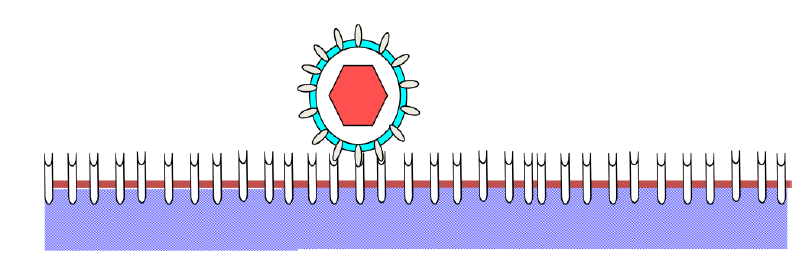Replication of virus
The process of multiplication of virus is referred as a replication. Since viruses are obligatory parasite at all stage of replication, the virion genome and genome encoded macromolecules interact with the host cellular structure and their pathways of macromolecular synthesis.
For a specific virus to replicate within host:
The host cell must be permissive and virus must be compatible within the hosts cell.
The viral genome must possess the information for modifying normal metabolism of host cell.
- The host cell must not degrade the virus.
- The virus must be able to use the metabolic capabilities of the host cells to produce new virus particles containing replicated copies of the viral genome.
Although the specific details of virus are different from virus to virus, general strategy for the replication in viruses is same.
The different steps involved in virus replication are given below:
- Attachment/Adsorption
- Penetration early events
- Uncoating of the viral genome
- Biosynthesis of nucleic acids and protein (i.e. gene expression and genomic replication)
Substages:
- Early viral mRNA synthesis (Early transcription)
- Early viral protein synthesis (Early translation) middle events
- Viral genome replication
- Late mRNA synthesis (late transcription)
- Late viral protein synthesis (Late translation)
- Maturation/ assembly of virus proteins Late events
- Release of virion from host cell
- Attachment/Adsorption
- The first event in the infection of a cell by a virus is the attachment of virus particles to the cell surface component of the host.
- The proteins on the surface of virion attach to the specific receptors on the cell surface through specific receptors on the cell surface through weak and non-covalent bonding.
- The specificity of attachment determines the host range of the virus.
- Some viruses have a narrow range where as others have a quite a broad range. For e.g. Polio virus can enter the cells of only humans and other primates where as rabies virus can enter all mammalin cells
- The receptors on the cell surface components are proteins, polysaccharides and lipoproteins.
- In the absence of receptor sites. The virus cannot adsorb and hence can’t infect.
- If the receptor site is altered, the host may become resistant to the viral infection. However, mutant virion can also arise to adsorb to the resistant host.
- HIV (GP 120) attaches to CD4 proteins on helper T-cells.
- Rabies virus attach to acetylcholine receptor.

- Penetration
- Attachment is followed by penetration; the penetration of virus depends on the nature of the host cell.
- Some non-enveloped virus enters by their translocation of whole virus across the cell membrane (receptor-mediated endocytosis). For e.g. polio virus
- But, in some enveloped and non-enveloped virus, the virus penetrates through engulfment within the host cell membrane bounded vacuole. This phenomenon is quite similar to phagocytic process and called viropexsis.
- Most enveloped virus enter the host by cell fusion of the host cell membrane and viral membrane or envelope (membrane fusion)
- Uncoating of Nucleic acid
- The Uncoating of non-enveloped viruses in the cell cytoplasm or in vesicle is poorly understood, but it is assumed that interaction of virion with host components and enzymes lead to the breakdown of the virion and release of the genome.
- The proteolytic enzymes with lysozymes mainly involed in this process.
- The Uncoating of Reo virus takes place within lysozyme.
- The Uncoating of enveloped virus takes place within the vacuole in the cytoplasm or in the nucleolus depending on the virus type.
- Biosynthesis of nucleic acids and proteins
- This stage includes the formation of viral nucleic acid, capsids and enzymes necessary in various stages of viral synthesis, assembly and release.
- In addition, some regulatory proteins are also synthesized which serve to shut down normal cellular metabolism and direct sequential production of viral components.
- The site of viral replication depends on virus type.
- Most DNA viruses except pox virus replicate in the nucleolus.
- Most RNA viruses synthesizes their cellular components in the cytoplasm except orthomyxovirus and Paramyxovirus.
- Retroviruses synthesizes their particles partly in cytoplasm and partly in nucleolus.
The biosynthesis of viruses consists of the following steps:
a. Early transcription
The early mRNA is synthesized from nucleic acid.
b. Early translation
The term early is defined as occurring before replication of the genome. The early or non-structural proteins are enzymes required during the process of viral replication.
c. Replication of viral genome
The early proteins (enzymes) sucha as DNA polymerase and mediates the replication of viral genome.
d. Late transcription
It is the crucial step in viral replication. viral mRNA are transcribed form viral nucleic acid utilizing host resources.
e. Late translation
The late proteins are synthesized which are used as structural proteins (capsid) in progeny viruses.
5. Maturation and assembly:
Following the synthesis of viral proteins and nucleic acids, allthe viral components assemble together to form a complete viral particles. The progeny virus particles are assembled by packaging of viral nucleic acids within the capsid protein.
6. Release
The complete virus particles may release outside the host cell through following mechanism:
- Through lysis of host cell (occurs generally in naked virus).
- Through budding (generally occurs in enveloped virus).
The budding process begins when the virus specific proteins enter the cytoplasmic membrane at the specific sites. The viral nucleocapsid then interacts with the specific membrane site mediated by the matrix protein. The cell membrane evaginates at that site and an envelope particles bud off from the membrane. Budding frequently doesn’t damage the cell and in certain instances the cell survives while producing large number of budding virus, the cell can be killed.
Try to solve the new Formula Cube! It works exactly like a Rubik's Cube but it is only $2, from China. Learn to solve it with the tutorial on rubiksplace.com or use the solver to calculate the solution in a few steps.



